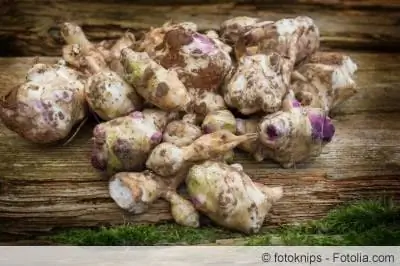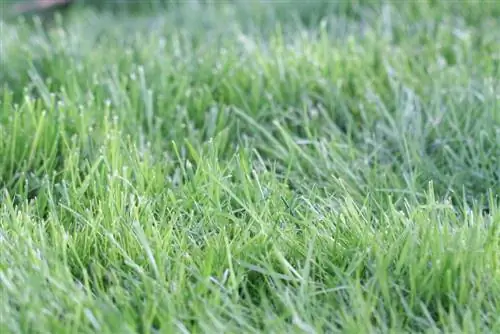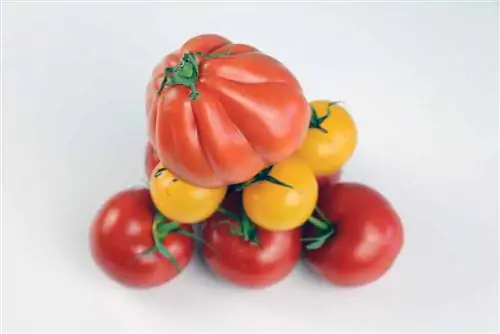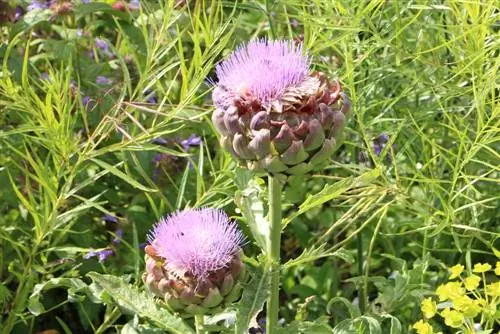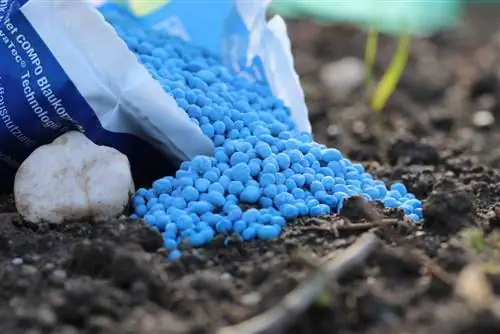- Author admin [email protected].
- Public 2023-12-17 03:39.
- Last modified 2025-01-24 12:45.
Jerusalem artichoke has the botanical name Helianthus tuberosus and belongs to the daisy family, meaning the plant belongs to the same genus as the native sunflower. The root tubers are edible and have now become established on many menus around the world. As a useful plant, Jerusalem artichoke is extremely versatile and can be eaten both raw and cooked. When it comes to ingredients, consumers can expect many important nutrients and fiber, which help with various he alth problems. There is now a wide variety of varieties on offer for gourmets.
Origin
Jerusalem artichoke is originally from South America; the Brazilian Indians from the Tupinambá tribe are most likely responsible for this unusual name. The flowers of the potato-like crop look very similar to the sunflower, as both plants belong to the same genus. Jerusalem artichoke came to Europe with colonization and from here it began a worldwide triumph. Although the sweet-tasting root tuber was largely replaced by the potato over the course of the century, it is now experiencing a comeback, especially in organic cultivation:
- Originally used as livestock feed and vegetables
- South American Indians value the root tuber as a tasty staple food
- Also has an appetite-suppressing effect, ideal for long hikes
- Strong and sprawling growth ensures favorable cultivation
- Acts as a useful remedy for many he alth problems
- It is also colloquially referred to as earth pear, earth artichoke, earth truffle, Indian tuber and sweet potato
Ingredients

Jerusalem artichoke is extremely low in calories; the root tubers consist of almost 80% water and around 16% carbohydrates. The carbohydrates contained in Jerusalem artichoke consist primarily of the polysaccharide inulin. Compared to potato starch, inulin has the big advantage that it only causes a very small increase in blood sugar after consumption. In this way, the production of insulin in the pancreas is only marginally increased. This is why Jerusalem artichoke is ideal for diabetics and people who are overweight. Not only does the inulin have little impact on blood sugar levels, but it also has a suppressing effect on appetite:
- Compared to potatoes, Jerusalem artichokes only have about 1/3 of calories
- Rich in nutrients and fiber
- Contains the following minerals: calcium, iron, potassium, silica, copper, magnesium, manganese, sodium, phosphorus, selenium and zinc
- Rich in vital vitamins: A, B 1, B 2, C 1, beta-carotene and nicotinic acid
- Contains trace elements and protein
- Inulin has a stimulating effect on intestinal he alth, promotes the bacterial strains of bifidus and lacto bacteria
- Inulin repels harmful and carcinogenic substances in the intestine
- Inulin is now used in the production of food as a low-calorie fat substitute
Flowers, growth & root tubers
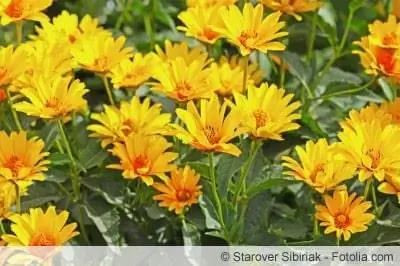
Topinambur has enormous growth power and quickly spreads over a wide area, which is why the plant should be pruned and harvested early. Some remnants of the root tubers remain in the ground for further distribution. The tubers differ greatly depending on the variety and vary not only in size, but also in shape and color. The following criteria are important for flowers, growth and root tubers:
- Perennial and herbaceous crop with upright growth
- Even fragments of the tubers are enough to sprout again
- Growth heights under ideal site conditions of up to 3 m
- Several branched stems form from the tuber
- Bulbs are either round, oval, roller or pear-shaped
- Leaves are stalked and ovate, approx. 7-10 cm wide and 10-25 cm long
- Produces beautiful, sunflower-like flowers
- Inflorescences are cup-shaped and hermaphroditic
- Flowering period from August until the late autumn months
- Plant dies above ground at the end of autumn
- Bulbs are hardy and overwinter in the ground without any problems
- The tubers can be harvested from late autumn to spring if the ground is not frozen
Tip:
The root tubers very quickly lose their fresh and juicy consistency during storage and become limp and tasteless. Therefore, only the quantity intended for immediate consumption should be purchased or harvested.
Taste & Preparation
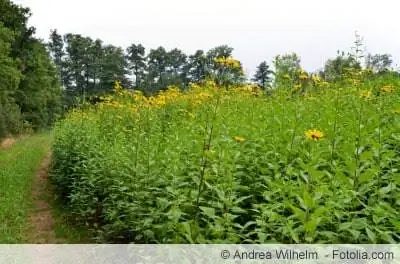
The root tuber has a spicy taste and can be prepared in many ways. When it comes to the consistency when you bite, parallels can be drawn with carrots. If Jerusalem artichoke is used raw, it is better to place it in a bowl of cold water after peeling and cutting and add a little lemon juice, otherwise the vegetable will quickly turn gray and unsightly. The root tubers do not last long after harvest, so they should be used promptly. In addition to being used for preparing food, the above-ground herb is used as food for animals. In addition, the tubers can be used to distill schnapps, which is an insider tip among connoisseurs. The following aspects are crucial to the taste and preparation:
- Raw tuber tastes mild and nutty
- Can be prepared like potatoes
- It is possible to boil, puree as a soup, fry as chips and bake
- Cooked Jerusalem artichokes have a slightly sweet taste
- The taste is reminiscent of artichoke and salsify
- Grate raw tubers for salads
- Sweets are also possible, grate the tubers raw and add them to the fruit salad or soufflé
- Suitable spices: herbs, garlic, horseradish, nutmeg and lemon juice
- If you have problems with flatulence, add fennel and caraway seeds
- Season sparingly with s alt
Tip:
If the sweet taste is not desired after cooking, then some lemon juice should be added to the Jerusalem artichoke during the cooking process.
Recommended varieties
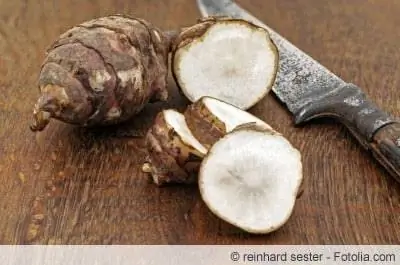
Nowadays Jerusalem artichokes are available in many different varieties from specialist retailers. Normal supermarkets rarely stock the root tubers because they only have a limited shelf life. The color of the shells ranges from a reddish brown to a whitish yellow. In general, it can be said that varieties with a lighter skin have a slightly finer taste. The Jerusalem artichoke varieties were bred for different purposes. The size of the tubers, the herb yield and the proportion of inulin play an important role here. In addition, the timing of harvest and the color of the tubers are important for breeding:
- Varieties differ in the following points: taste, flowering or Harvest time, tuber color, size and characteristics of the tubers, intended use
- Good yellow: edible tuber, medium late ripening, yellow tuber color, high harvest yield
- Topstar: edible tuber, early ripening time, yellow tuber color
- Red zone ball: herb yield and liquor, medium-late ripening time, red tuber color
- Bianca: edible tuber, early ripening time, yellow tuber color, growth height up to 2.5 m
- Forest spindle: herb yield and liquor, medium-late ripening time, red tuber color
- Violet de Rennes: edible tuber, medium late ripening, red tuber color, growth height up to 2 m
- Topianka: herb yield and liquor, medium-late ripening, yellow tuber color
- Henriette: edible tuber, early ripening time, yellow tuber color
- Giant: edible tuber, early ripening time, red tuber color
- Patate: edible tuber, medium late ripening, red tuber color
- Sakhalinski rouge: edible tuber, medium late ripening, red tuber color
- Völkerroder Spinde: Edible tuber, early ripening time, yellow tuber color
- Lola: edible tuber, medium late ripening, red tuber color
- Medius: edible tuber, medium late ripening, yellow tuber color
- Fuseau 60: Edible tuber, medium late ripening, forms daughter tubers
- Land variety red: edible tuber, late ripening time, red tuber color
- Land variety White: Edible tuber, late ripening time, whitish-yellow tuber color
- Dornburger: Edible tuber, late ripening time, red tuber color
Conclusion
Jerusalem artichoke is a delicious root vegetable that can be prepared and used in many ways. The root tubers have much fewer calories compared to potatoes and are therefore very popular with overweight people. In addition, the crop does not produce potato starch, but rather inulin, which only causes the blood sugar level to rise very slightly. For this reason, Jerusalem artichoke is ideal for diabetics as a substitute for potatoes. The tubers contain many important vitamins, nicotinic acid, biotin and have an extremely high potassium content. Jerusalem artichoke also contains numerous important trace elements and minerals. The taste of the tubers is hearty and mild, with a nutty note when raw. When cooked, the root vegetables have a slightly sweet flavor that is reminiscent of carrots. Nowadays there is a large variety of varieties available, but mostly only from specialist retailers because the tubers cannot be stored for long. Therefore, only enough should be harvested or purchased for consumption so that it is exactly enough for the desired meal. Otherwise the root tubers quickly become limp and lose their spicy taste.

